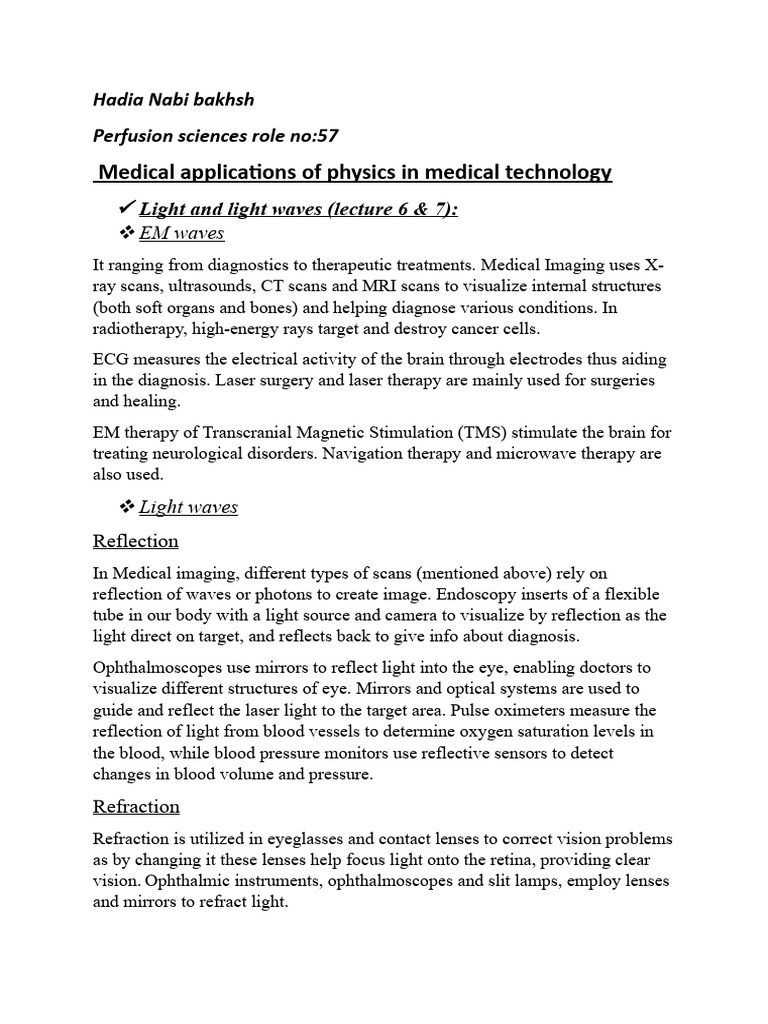What if you could transform the intricate ballet of cellular activity into a symphony of mathematical equations? The marriage of physics and medicine is not merely a whimsical notion; it is an empirical reality that propels medical technology forward, enhancing both diagnostics and therapeutic interventions. With this in mind, one might ponder: how far are we willing to go to embrace the principles of physics in the pursuit of medical innovation? This inquiry serves as a foundation for exploring the multifaceted applications of physics in medicine, inviting both contemplation and analysis.
The realm of medical imaging is perhaps the most prominent intersection of physics and healthcare. Techniques such as X-ray imaging, computed tomography (CT), magnetic resonance imaging (MRI), and ultrasound rely heavily on the principles of physics to visualize the human body in exquisite detail. X-ray imaging, an indispensable tool in modern diagnostics, operates on the principle of differential absorption of X-rays by various tissues, enabling the identification of fractures, tumors, and infections. Here, the transformation of electromagnetic radiation into diagnostic information epitomizes the practicality of physics in clinical settings.
Advancing our understanding further, computed tomography harnesses a series of X-ray images taken from multiple angles, which a sophisticated algorithm then reconstructs into a multidimensional representation of the body’s internal architecture. This fusion of axial imaging and computational physics illustrates the essential role of technological advancement in enhancing diagnostic accuracy and patient outcomes.
Similarly, magnetic resonance imaging leverages nuclear magnetic resonance principles, wherein the alignment of hydrogen nuclei in a magnetic field produces detailed images of soft tissues. The intricate dance of radiofrequency pulses and resulting signals exemplifies the elegance of physics embedded in medical diagnostics. The applications of MRI extend beyond mere imaging; its utilization in functional MRI (fMRI) allows researchers to observe cerebral blood flow changes, shedding light on cognitive processes and neurological disorders.
Moreover, ultrasound, a safe and non-invasive imaging modality, employs sound waves to visualize internal structures. The concept of acoustic impedance plays a critical role in this technique, as varying densities of tissues reflect sound waves differently. This reflects the dual nature of physics—its ability to serve both as a diagnostic tool and a therapeutic agent.
Indeed, the therapeutic applications of physics in medicine are equally profound. Radiotherapy, particularly in the treatment of cancer, exemplifies the application of ionizing radiation for therapeutic purposes. The physics involved in targeting tumor cells while minimizing damage to adjacent healthy tissues necessitates an intricate balance. Techniques such as proton therapy utilize charged particles instead of conventional X-rays, providing a modulated energy deposition profile that is advantageous in sparing surrounding tissues. The fusion of medical physics with oncology exemplifies a critical area where physics contributes to enhancing treatment efficacy and minimizing collateral damage to patients.
A burgeoning domain within therapeutic physics is the application of laser technology. Lasers are employed in various procedures ranging from delicate eye surgeries to rigorous dermatological interventions. The precision of laser treatments is underpinned by the principles of optics, including wavelength selection and photothermal interactions. Understanding the interaction of light with biological tissues allows for targeted interventions with minimal invasiveness, showcasing the sophistication of physical principles in the development of medical technology.
While the above examples primarily emphasize imaging and therapeutic modalities, the impact of physics extends further into biophysics and the molecular realm. The principles of thermodynamics, fluid dynamics, and molecular interactions inform our understanding of biological processes at the cellular and systemic levels. The study of nanotechnology is another remarkable intersection of physics and medicine, with nanoparticles being engineered for targeted drug delivery, imaging agents, and even as tools for photothermal therapy.
Moreover, the evolution of wearable technology, often anchored by physicists’ insights into sensors and data analytics, revolutionizes the monitoring of physiological parameters. Consider the potential of real-time blood glucose monitoring facilitated by physiological sensors—this integration of physics into everyday medical management presents new challenges and opportunities in chronic disease management.
As we examine these interdisciplinary applications, we must also consider the ethical implications and challenges accompanying the integration of physics in medicine. The rapid pace of technological innovation raises pertinent questions concerning data privacy, informed consent, and the potential for disenfranchisement. How do we ensure equitable access to these advancements while simultaneously harnessing their capabilities to enhance patient care?
In conclusion, the applications of physics in medicine are extensive, ranging from novel imaging techniques and treatment modalities to the exploration of biophysical phenomena. This intricate relationship not only enhances our understanding of the human body but also propels the development of advanced medical technologies. As we continue to widen the scope of inquiry, we stand at the precipice of a future where the synergy of physics and medicine could yield extraordinary breakthroughs. Are we ready to embrace this journey and unlock new potential in the field of healthcare?












